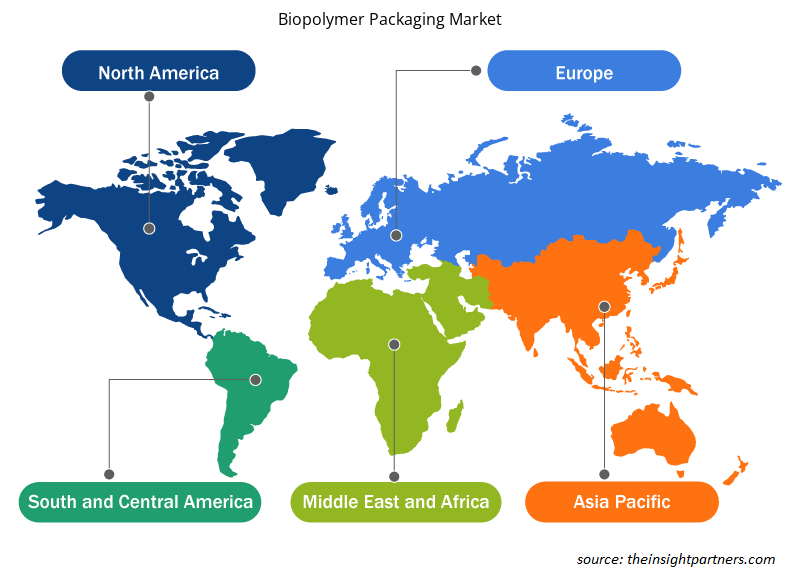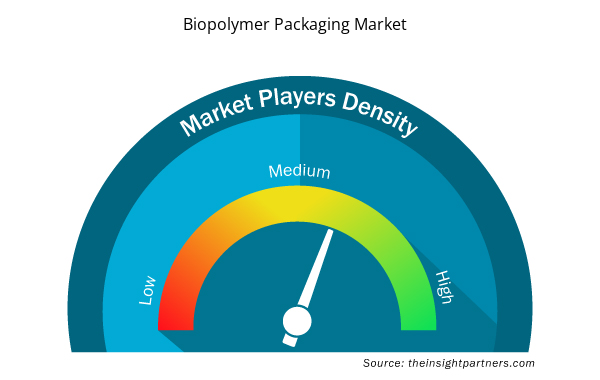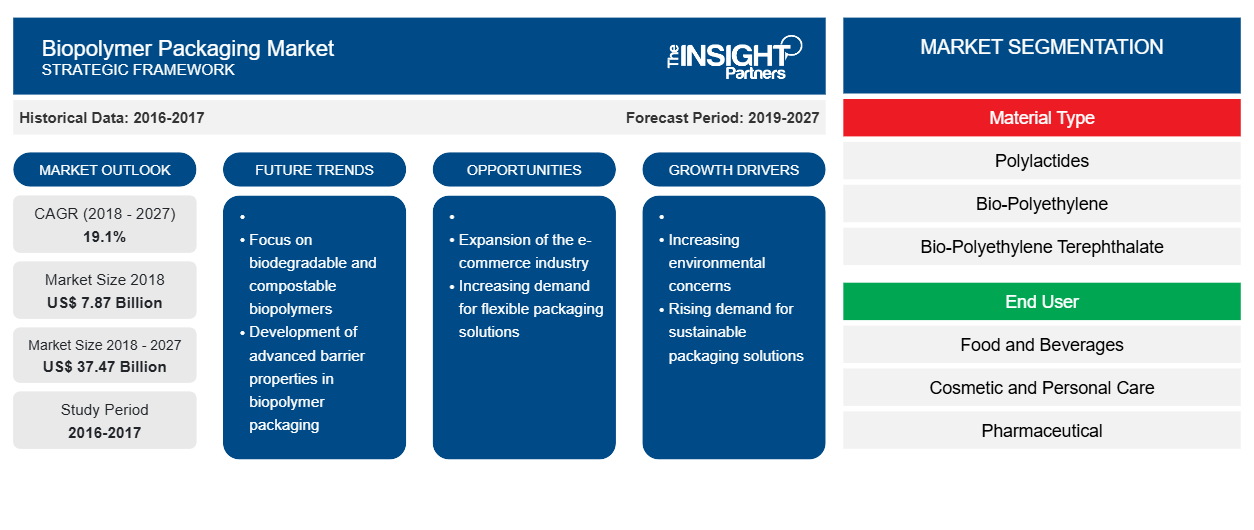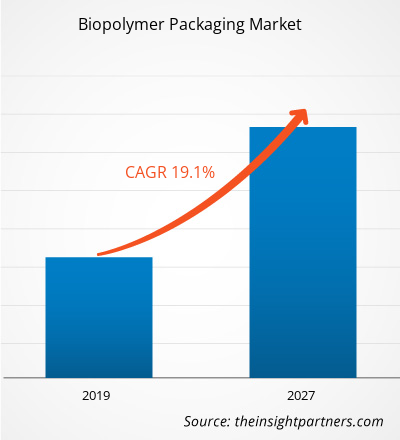Der Markt für Biopolymerverpackungen wurde im Jahr 2018 auf 7.872,54 Millionen US-Dollar geschätzt und soll bis 2027 einen Wert von 37.465,07 Millionen US-Dollar erreichen; von 2019 bis 2027 dürfte er mit einer durchschnittlichen jährlichen Wachstumsrate von 19,1 % wachsen.
Biopolymere sind biologisch abbaubare Polymere, die aus Stärke, Zucker, Kollagen , Zellulose und anderen Substanzen bestehen. Sie werden zunehmend in Verpackungsanwendungen eingesetzt, da die Nachfrage in der Lebensmittel- und Getränkeindustrie, der Körperpflegebranche und der Pharmaindustrie steigt und strenge Vorschriften für die Verwendung synthetischer Polymere in Verpackungen gelten.
Aufgrund verschiedener Gesetze , proaktiver Regulierungsbemühungen und der Einschränkung der Verwendung herkömmlicher Kunststoffverpackungslösungen ist Europa der größte Abnehmer von Biopolymerverpackungen . Die günstigen staatlichen Bestimmungen in Frankreich, Italien und Spanien haben zum Aufbau eines positiven Marktes für Biopolymerverpackungen in dieser Region beigetragen. Darüber hinaus wird für die Region in den kommenden Jahren ein Anstieg ihrer Produktionskapazität erwartet. Die steigende Verbrauchernachfrage nach nachhaltigen Produkten, schnelle Investitionen in F&E-Aktivitäten und politische Unterstützung für die Bioökonomie sind die Hauptfaktoren, die Europa zu einer führenden Region für Biopolymerverpackungen machen . Die europäische Biokunststoffindustrie erzielt Fortschritte in Bezug auf die technischen Eigenschaften und Funktionalität von Biokunststoffen, gefördert durch politische Initiativen, die Innovation sowie Forschung und Entwicklung durch Finanzierung und Zuschüsse unterstützen. Europa hat die Bedeutung von Standardisierung und Zertifizierung erkannt, um die Entwicklung der biologisch abbaubaren Verpackungen voranzutreiben.
Die COVID-19-Pandemie begann im Dezember 2019 in Wuhan (China) und hat sich seitdem rasant über den Globus verbreitet. Die USA, Brasilien, Indien, Russland, Italien, China, Spanien, Frankreich und Deutschland gehören zu den am schlimmsten betroffenen Ländern in Bezug auf bestätigte Fälle und gemeldete Todesfälle (Stand: Juni 2020). Die Pandemie hat Volkswirtschaften und Industrien durch erzwungene Ausgangssperren , Reiseverbote und Betriebsschließungen beeinträchtigt . Die Chemie- und Materialindustrie ist eine der weltweit wichtigsten Industrien, die infolge dieses Ausbruchs mit schwerwiegenden Störungen wie Unterbrechungen der Lieferkette, Absagen von Technologieveranstaltungen und Büroschließungen konfrontiert ist . Der globale wirtschaftliche Zusammenbruch aufgrund von COVID-19 beeinträchtigt auch das Wachstum des Marktes für Biopolymerverpackungen aufgrund von Fabrikschließungen und Hindernissen in der Lieferkette.
Passen Sie diesen Bericht Ihren Anforderungen an
Sie erhalten kostenlos individuelle Anpassungen an jedem Bericht, einschließlich Teilen dieses Berichts oder einer Analyse auf Länderebene, eines Excel-Datenpakets sowie tolle Angebote und Rabatte für Start-ups und Universitäten.
- Holen Sie sich die wichtigsten Markttrends aus diesem Bericht.Dieses KOSTENLOSE Beispiel umfasst eine Datenanalyse von Markttrends bis hin zu Schätzungen und Prognosen.
Markteinblicke
Steigender Bedarf an nachhaltigen Verpackungslösungen
Kunststoffverpackungen werden in zahlreichen Anwendungsbereichen eingesetzt, beispielsweise in den Bereichen FMCG , Lebensmittel und Getränke, Pharmazeutika und Konsumgüter. Die zunehmende Verwendung von Kunststoff in mehreren Endverbraucherbranchen ist für die zunehmende Umweltverschmutzung verantwortlich. Daher werden das Recycling und die Wiederverwendung von Kunststoff zu wichtigen Faktoren für Innovation und Nachhaltigkeit. Darüber hinaus wird herkömmlicher Kunststoff in Zukunft voraussichtlich teurer werden, da die Rohstoffquellen knapper werden. Seit einigen Jahren beeinflusst Biokunststoff die Kunststoffbranche durch Innovationen hin zu mehr Ressourceneffizienz, Funktionalität und Nachhaltigkeit. Biopolymere spielen eine wichtige Rolle bei der Erhöhung der Recyclingziele und der Abfallbewirtschaftung, indem sie Erdölressourcen durch erneuerbare Ressourcen ersetzen. Biopolymere werden aus erneuerbaren pflanzlichen Ressourcen hergestellt, die wenig toxisch, besser recycelbar und gut biologisch abbaubar sind . Darüber hinaus steigen viele Branchenakteure auf biobasierte Materialien aus fossilen Ressourcen um, um biologisch abbaubare Verpackungslösungen anzubieten. Angesichts der wachsenden Bevölkerung und der steigenden Nachfrage finden Verpackungshersteller innovative Wege, um die gestiegene Nachfrage nach erneuerbarem Kunststoff mit verbesserter Produktqualität zu decken. Daher treibt die steigende Nachfrage nach nachhaltigen Verpackungslösungen das Wachstum des globalen Marktes für Biopolymerverpackungen voran.
Materialtypbasierte Erkenntnisse
Basierend auf dem Materialtyp ist der Markt für Biopolymerverpackungen in Polylactide ( PLA ), Bio-Polyethylen (PE), Bio-Polyethylenterephthalat ( PET), Stärke, Zellulose, PBAT , Polyhydroxyalkanoate ( PHA ), Polybutylensuccinat (PBS) und andere unterteilt. Im Jahr 2018 dominierte das Stärkesegment den Markt für Biopolymerverpackungen ; jedoch wird erwartet, dass der Markt für Polyhydroxyalkanoate ( PHA ) im Prognosezeitraum mit der höchsten CAGR wächst. Stärkemischungen sind die am häufigsten verwendete Biomassequelle zur Herstellung von Biopolymeren . Es handelt sich um ein natürliches Polymer, das aus Mais, Weizen, Reis, Gerste, Sorghum, Kartoffeln und anderen derartigen Produkten hergestellt wird. Stärkebasierte Kunststoffe sind Thermoplaste, die durch Mischen mit Additiven und Weichmachern wie Glycerin und Sorbit entstehen . Da sich aus Stärkemischungen durch die Einarbeitung in viele Polymere oder Biopolymere auf Erdölbasis einzigartige Verbundwerkstoffe herstellen lassen , finden sie in zahlreichen Anwendungen Verwendung. Die Bedeutung von Stärkemischungen hat mit der Einführung verbesserter Harzqualitäten mit geringer Toxizität, Biokompatibilität sowie mechanischen und Abbaueigenschaften zugenommen. Die stärkebasierten Biopolymere wie Folien und Kunststoffe werden in der Verpackungsindustrie häufig zur Herstellung von Bechern, Besteck, Eierkartons, Strohhalmen, Einwegtüten, Schüsseln, Flaschen, Müllbeuteln und kompostierbaren Folien für die Landwirtschaft verwendet.
Endbenutzerbasierte Erkenntnisse
Basierend auf dem Endverbraucher ist der Markt für Biopolymerverpackungen in Lebensmittel und Getränke, Kosmetik und Körperpflege, Pharmazeutika und Sonstiges unterteilt. Das Segment Lebensmittel und Getränke machte einen erheblichen Anteil des globalen Marktes für Biopolymerverpackungen aus; das Segment Kosmetik und Körperpflege dürfte während des Prognosezeitraums die höchste durchschnittliche jährliche Wachstumsrate verzeichnen. Die Nachfrage nach Biopolymerverpackungen wie Stärkemischungen, PLA und anderen in Lebensmittel- und Getränkeanwendungen dürfte steigen. Mit dem zunehmenden Fokus auf Nachhaltigkeit haben mehrere Lebensmittel- und Getränkehersteller stattdessen Verpackungslösungen auf Biopolymerbasis eingeführt, um Treibhausgasemissionen einzudämmen. So ging PepsiCo im Oktober 2016 eine Partnerschaft mit Danimer Scientific zur Herstellung von biologisch abbaubaren Filmharzen von Danimer Scientific ein, um das Ziel der Nachhaltigkeit zu erreichen.
Unternehmen verfolgen häufig verschiedene Strategien, um ihre Präsenz weltweit zu erweitern. Arkema Group, BASF SE., Biome Bioplastics und Spectra Packaging gehören zu den Hauptakteuren auf dem globalen Markt für Biopolymerverpackungen, die diese Strategien umsetzen, um ihren Kundenstamm zu vergrößern und bedeutende Marktanteile zu gewinnen, was ihnen wiederum ermöglicht, ihren Markennamen weltweit zu behaupten.
Regionale Einblicke in den Markt für Biopolymerverpackungen
Die regionalen Trends und Faktoren, die den Markt für Biopolymerverpackungen im Prognosezeitraum beeinflussen, wurden von den Analysten von Insight Partners ausführlich erläutert. In diesem Abschnitt werden auch die Marktsegmente und die Geografie von Biopolymerverpackungen in Nordamerika, Europa, im asiatisch-pazifischen Raum, im Nahen Osten und Afrika sowie in Süd- und Mittelamerika erörtert.

- Erhalten Sie regionale Daten zum Markt für Biopolymerverpackungen
Umfang des Marktberichts zu Biopolymerverpackungen
| Berichtsattribut | Details |
|---|---|
| Marktgröße im Jahr 2018 | 7,87 Milliarden US-Dollar |
| Marktgröße bis 2027 | 37,47 Milliarden US-Dollar |
| Globale CAGR (2018 - 2027) | 19,1 % |
| Historische Daten | 2016-2017 |
| Prognosezeitraum | 2019–2027 |
| Abgedeckte Segmente | Nach Materialtyp
|
| Abgedeckte Regionen und Länder | Nordamerika
|
| Marktführer und wichtige Unternehmensprofile |
|
Marktteilnehmerdichte für Biopolymerverpackungen: Auswirkungen auf die Geschäftsdynamik verstehen
Der Markt für Biopolymerverpackungen wächst rasant, angetrieben durch die steigende Nachfrage der Endverbraucher aufgrund von Faktoren wie sich entwickelnden Verbraucherpräferenzen, technologischen Fortschritten und einem größeren Bewusstsein für die Vorteile des Produkts. Mit steigender Nachfrage erweitern Unternehmen ihr Angebot, entwickeln Innovationen, um die Bedürfnisse der Verbraucher zu erfüllen, und nutzen neue Trends, was das Marktwachstum weiter ankurbelt.
Die Marktteilnehmerdichte bezieht sich auf die Verteilung der Firmen oder Unternehmen, die in einem bestimmten Markt oder einer bestimmten Branche tätig sind. Sie gibt an, wie viele Wettbewerber (Marktteilnehmer) in einem bestimmten Marktraum im Verhältnis zu seiner Größe oder seinem gesamten Marktwert präsent sind.
Die wichtigsten auf dem Markt für Biopolymerverpackungen tätigen Unternehmen sind:
- Arkema-Gruppe
- BASF SE
- Biome Bioplastics Limited
- Cardia Bioplastics
- Innovia-Filme
Haftungsausschluss : Die oben aufgeführten Unternehmen sind nicht in einer bestimmten Reihenfolge aufgeführt.

- Überblick über die wichtigsten Akteure auf dem Markt für Biopolymerverpackungen
Globaler Markt für Biopolymerverpackungen – nach Materialtyp
- Polylactide (PLA)
- Bio-Polyethylen (PE)
- Bio-Polyethylenterephthalat (PET)
- Stärke
- Zellulose
- PBAT
- Polyhydroxyalkanoate (PHA)
- Poly(butylensuccinat) (PBS)
- Sonstiges
Globaler Markt für Biopolymerverpackungen – nach Endverbraucher
- Essen und Trinken
- Kosmetik und Körperpflege
- Pharmazeutische
- Sonstiges
Firmenprofile
- Arkema-Gruppe
- BASF SE
- Biome Bioplastics Limited
- Cardia Bioplastics
- Innovia-Filme
- NatureWorks LLC
- Plantic Technologies Limited
- Spectra Verpackungen GmbH
- United Biopolymers SA
- Die Dow Chemical Company
- Historische Analyse (2 Jahre), Basisjahr, Prognose (7 Jahre) mit CAGR
- PEST- und SWOT-Analyse
- Marktgröße Wert/Volumen – Global, Regional, Land
- Branche und Wettbewerbsumfeld
- Excel-Datensatz



Report Coverage
Revenue forecast, Company Analysis, Industry landscape, Growth factors, and Trends

Segment Covered
This text is related
to segments covered.

Regional Scope
North America, Europe, Asia Pacific, Middle East & Africa, South & Central America

Country Scope
This text is related
to country scope.
Häufig gestellte Fragen
With the stringent government regulations for waste management worldwide, the environmental awareness is growing among consumers thus, cosmetic & personal care industry is taking initiatives towards biopolymer packaging. Selecting an appropriate biopolymer packaging is critical for the cosmetic industry as several factors are taken into consideration such as temperature, chemical reactions etc. Further, the development of new technologies have made biopolymers more accessible to packaging manufacturers and suppliers of plastic packaging.
The major players operating in the global biopolymer packaging market are Arkema Group, BASF SE , Biome Bioplastics Limited , Cardia Bioplastics , Innovia Films , NatureWorks LLC, Plantic Technologies Limited , Spectra packaging ltd., United Biopolymers, S.A., The Dow Chemical Company, and BEWiSynbra Group ; among many others.
In 2018, the biopolymer packaging market was predominant in Europe at the global level. The market’s growth is strongly supported by rise in income levels for European population along with continuous research and development, to expand the application base of biopolymer packaging have led to the increased widespread adoption. The popularity of the biopolymer packaging has increased within the region, particularly in Germany, France, UK, and other regions.
Trends and growth analysis reports related to Chemicals and Materials : READ MORE..
The List of Companies - Biopolymer Packaging Market
- Arkema Group
- BASF SE
- Biome Bioplastics Limited
- Cardia Bioplastics
- Innovia Films
- NatureWorks LLC
- Plantic Technologies Limited
- Spectra Packaging Ltd.
- United Biopolymers, S.A.
- The Dow Chemical Company
- BEWiSynbra Group
The Insight Partners performs research in 4 major stages: Data Collection & Secondary Research, Primary Research, Data Analysis and Data Triangulation & Final Review.
- Data Collection and Secondary Research:
As a market research and consulting firm operating from a decade, we have published and advised several client across the globe. First step for any study will start with an assessment of currently available data and insights from existing reports. Further, historical and current market information is collected from Investor Presentations, Annual Reports, SEC Filings, etc., and other information related to company’s performance and market positioning are gathered from Paid Databases (Factiva, Hoovers, and Reuters) and various other publications available in public domain.
Several associations trade associates, technical forums, institutes, societies and organization are accessed to gain technical as well as market related insights through their publications such as research papers, blogs and press releases related to the studies are referred to get cues about the market. Further, white papers, journals, magazines, and other news articles published in last 3 years are scrutinized and analyzed to understand the current market trends.
- Primary Research:
The primarily interview analysis comprise of data obtained from industry participants interview and answers to survey questions gathered by in-house primary team.
For primary research, interviews are conducted with industry experts/CEOs/Marketing Managers/VPs/Subject Matter Experts from both demand and supply side to get a 360-degree view of the market. The primary team conducts several interviews based on the complexity of the markets to understand the various market trends and dynamics which makes research more credible and precise.
A typical research interview fulfils the following functions:
- Provides first-hand information on the market size, market trends, growth trends, competitive landscape, and outlook
- Validates and strengthens in-house secondary research findings
- Develops the analysis team’s expertise and market understanding
Primary research involves email interactions and telephone interviews for each market, category, segment, and sub-segment across geographies. The participants who typically take part in such a process include, but are not limited to:
- Industry participants: VPs, business development managers, market intelligence managers and national sales managers
- Outside experts: Valuation experts, research analysts and key opinion leaders specializing in the electronics and semiconductor industry.
Below is the breakup of our primary respondents by company, designation, and region:

Once we receive the confirmation from primary research sources or primary respondents, we finalize the base year market estimation and forecast the data as per the macroeconomic and microeconomic factors assessed during data collection.
- Data Analysis:
Once data is validated through both secondary as well as primary respondents, we finalize the market estimations by hypothesis formulation and factor analysis at regional and country level.
- Macro-Economic Factor Analysis:
We analyse macroeconomic indicators such the gross domestic product (GDP), increase in the demand for goods and services across industries, technological advancement, regional economic growth, governmental policies, the influence of COVID-19, PEST analysis, and other aspects. This analysis aids in setting benchmarks for various nations/regions and approximating market splits. Additionally, the general trend of the aforementioned components aid in determining the market's development possibilities.
- Country Level Data:
Various factors that are especially aligned to the country are taken into account to determine the market size for a certain area and country, including the presence of vendors, such as headquarters and offices, the country's GDP, demand patterns, and industry growth. To comprehend the market dynamics for the nation, a number of growth variables, inhibitors, application areas, and current market trends are researched. The aforementioned elements aid in determining the country's overall market's growth potential.
- Company Profile:
The “Table of Contents” is formulated by listing and analyzing more than 25 - 30 companies operating in the market ecosystem across geographies. However, we profile only 10 companies as a standard practice in our syndicate reports. These 10 companies comprise leading, emerging, and regional players. Nonetheless, our analysis is not restricted to the 10 listed companies, we also analyze other companies present in the market to develop a holistic view and understand the prevailing trends. The “Company Profiles” section in the report covers key facts, business description, products & services, financial information, SWOT analysis, and key developments. The financial information presented is extracted from the annual reports and official documents of the publicly listed companies. Upon collecting the information for the sections of respective companies, we verify them via various primary sources and then compile the data in respective company profiles. The company level information helps us in deriving the base number as well as in forecasting the market size.
- Developing Base Number:
Aggregation of sales statistics (2020-2022) and macro-economic factor, and other secondary and primary research insights are utilized to arrive at base number and related market shares for 2022. The data gaps are identified in this step and relevant market data is analyzed, collected from paid primary interviews or databases. On finalizing the base year market size, forecasts are developed on the basis of macro-economic, industry and market growth factors and company level analysis.
- Data Triangulation and Final Review:
The market findings and base year market size calculations are validated from supply as well as demand side. Demand side validations are based on macro-economic factor analysis and benchmarks for respective regions and countries. In case of supply side validations, revenues of major companies are estimated (in case not available) based on industry benchmark, approximate number of employees, product portfolio, and primary interviews revenues are gathered. Further revenue from target product/service segment is assessed to avoid overshooting of market statistics. In case of heavy deviations between supply and demand side values, all thes steps are repeated to achieve synchronization.
We follow an iterative model, wherein we share our research findings with Subject Matter Experts (SME’s) and Key Opinion Leaders (KOLs) until consensus view of the market is not formulated – this model negates any drastic deviation in the opinions of experts. Only validated and universally acceptable research findings are quoted in our reports.
We have important check points that we use to validate our research findings – which we call – data triangulation, where we validate the information, we generate from secondary sources with primary interviews and then we re-validate with our internal data bases and Subject matter experts. This comprehensive model enables us to deliver high quality, reliable data in shortest possible time.


 Holen Sie sich ein kostenloses Muster für diesen Bericht
Holen Sie sich ein kostenloses Muster für diesen Bericht